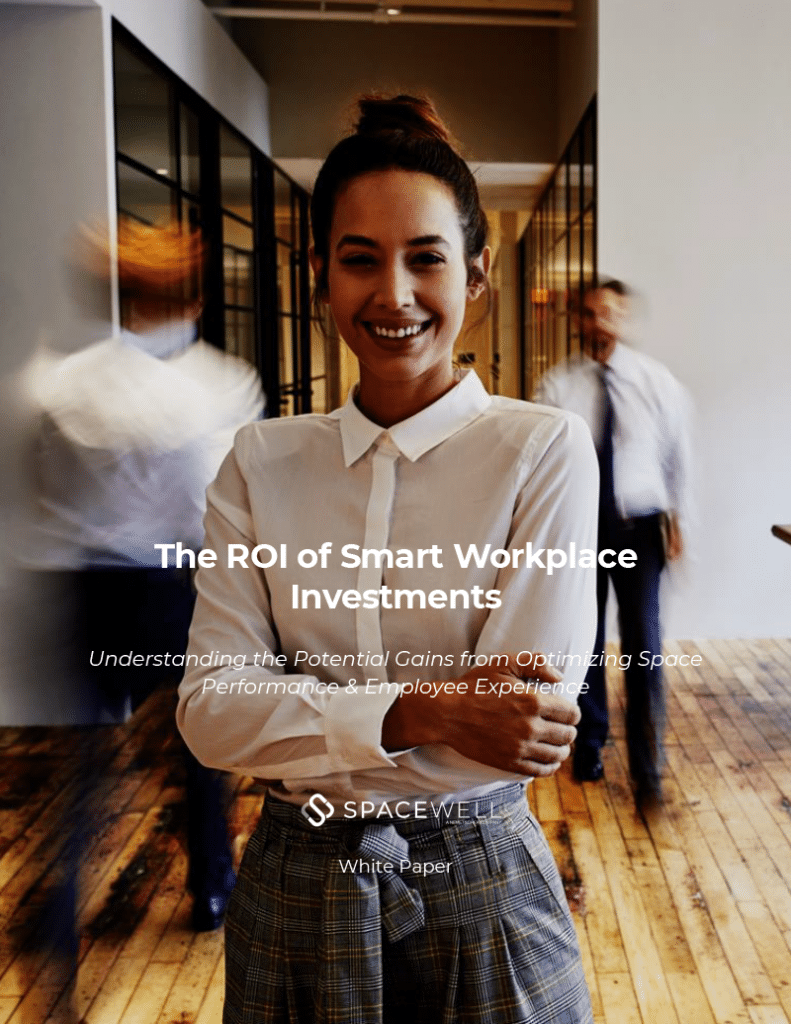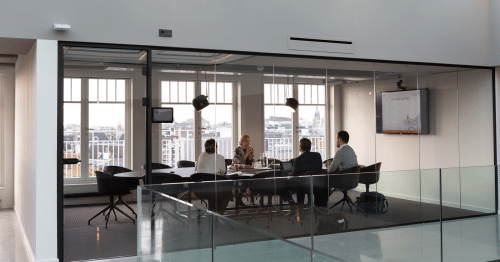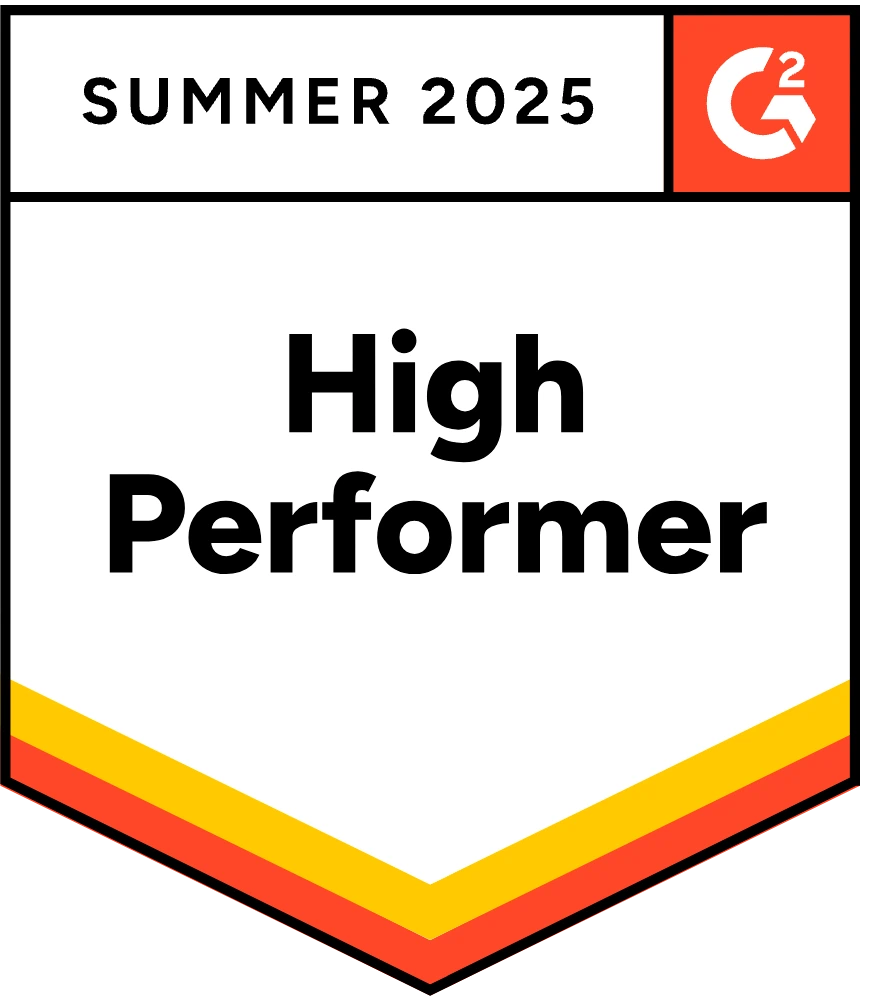The ROI of Smart Workplace Investments (White Paper)
Executive Summary
ROI of Smart Workplace Investments
Companies aiming to improve their workplaces are juggling a large set of competing demands for investment to support both on-site and remote work. With so many new priorities, a natural question to ask when evaluating any new product is how the returns on that investment (ROI) compare to those of other potential products.
Smart workplace solutions, which encompass hardware and software solutions to optimize the physical workplace, streamline ways of working in the office, and create a positive workplace experience. They have become increasingly cost-effective but can still represent a significant investment. Discussions of ROI for smart workplace technologies often stumble over the fact that the technologies have an extremely wide range of applications, not all of which will be relevant to every company, both because of differences in workplace cultures and existing technologies.
In order to help companies evaluate solutions, this smart workplace ROI paper outlines the different ways companies can capture return on investment from sensor-based workplace technologies aimed at optimizing space and employee experience. It draws heavily on third-party research to explain both the source and size of potential returns and outlines different approaches to calculating the ROI of smart workplace investments so that potential investors have all of the necessary tools to estimate the potential gains for their own office spaces.
Space Optimization
Perhaps the largest and most visible source of ROI from smart workplace solutions is the return on space optimization (see, for example, this AXA case study): If a company is able to eliminate an entire floor or building by cutting down on unnecessary space, the savings on rent, utilities, and services are substantial and easy to quantify to stakeholders. The same is true for avoiding future real estate investments: finding ways to make the most out of an existing portfolio (even if it doesn’t lead to space reductions) can help delay or reduce the amount of real estate required for expansion.
Space optimization falls into three types of approaches: footprint optimization focuses on managing the amount of space in aggregate; densification aims to optimize the amount of space per person; while optimizing the space mix ensures that the types of spaces provided actually align with the spaces employees need to support their work.
Optimizing the footprint of the workplace involves the comparison of the aggregated square footage of a location or portfolio to the actual need based on occupancy and utilization data. It takes place by aligning the actual use of each type of workspace to best practice benchmarks, subject to adjustments based on industry or company characteristics. Additionally, when setting optimization targets, it is critical to consider peak or maximum occupancy alongside the more commonly cited averages. Workplace sensor technologies are crucial to this optimization approach, delivering the continuous reporting and level of granularity that enables data-driven decision-making around when and how much space to add or release.
Densification refers to the reduction in the average amount of space per person by fitting more people into the same space. When done well, densification occurs without detracting from employee experience or productivity and may even result in a more varied workplace ecosystem as specialized spaces are added. The most well-known path to densification is the shift from individual, private offices to cubicles, bench seating, or other open-office desk arrangements. Another common path is to eliminate assigned seating altogether and reduce the desk-to-person ratio. In these densified environments, smart workplace solutions like sensors can help employees easily find and access the spaces they need by identifying which spaces are available in real-time. The benefits of densification can take the form of space savings, but research has also linked densified environments to higher productivity and collaboration.
Space mix optimization refers to the reconfiguration of collaboration spaces like conference rooms or huddle rooms to align the size of the space with actual usage patterns. More generally, it captures the attempt to align the demand and supply of space so that it is largely used at or near capacity. Space mix optimization takes place by measuring how often and how intensively a space is used over time, typically by means of headcount sensors, although other sensor and monitoring options exist. Actual measures are then compared to both occupancy and utilization benchmarks to evaluate the combined performance of each space, which can help identify which spaces are underperforming and, ideally, also understand why.
Optimizing the Employee Experience
Employee experience reflects efforts to enhance employee engagement, with benefits in terms of retention and productivity. Although the employee or workplace experience is shaped by a wide range of factors, some estimates suggest that the physical and technological environment each contributes up to 30 percent of the overall employee experience.
Workplace research on flexible and agile spaces provides one approach to understanding how technologies can enhance the employee experience, as these flexible work concepts rely heavily on technology to function smoothly. The types of productivity enhancements associated with workplace experience and enabled by smart workplace technology fall into several categories: purpose, autonomy, communication, and reputation.
Purpose describes the way in which technology helps employees find and access the spaces and tools they need to complete different types of tasks in the office. Additionally, purpose can also include the ability to match employees with spaces that fit their personalities or needs (such as difficulty concentrating in noisy environments or environmental preferences), separate from the actual tasks they are performing. Aligning space with purpose is one of the central tenets of activity-based working but is also the governing logic of other types of flexible work, including hybrid work.
Autonomy refers to the sense of efficacy that arises from employees’ ability to choose their workspace in the office. In this view, productivity (along with benefits like talent retention) is not just enhanced by having well-designed spaces that support certain types of activities but is also the result of the feeling of empowerment and satisfaction that comes with choice. This positive feeling, in turn, results in greater performance.
The concept of communication captures both serendipitous encounters that can spark creativity along with day-to-day teamwork and sense of community. One of the key ways technology can enhance workplace connections is by making it easier to find colleagues as well as to facilitate densification.
Reputation encompasses both the ability of the corporate image to provide gains in terms of talent attraction and retention, as well as broader benefits in terms of morale. Having a high-performing workplace, which includes both space and technology, has been associated with a number of positive outcomes, including being perceived as more innovative and more likely to be recommended to others by current employees.
Finally, in addition to the four categories above that are associated with a high-performing flexible workplace, technology also serves as a powerful tool in terms of optimizing the work environment for performance on an ongoing basis. Specifically, the ability to monitor and analyze data about how employees interact with space is not limited to understanding what size conference rooms employees prefer, but it can also be used to gather systematic data on how employees respond to changes in fit-out. Thus, a final benefit of technology is its ability to enable active experimentation in the workplace.
Each broad class of workplace optimization can be illustrated through simplified use cases, but the reality is that calculations are likely to be far more complex in practice. A single company might be deploying solutions across multiple locations that all have different average rent, salaries, or employee numbers. Even within two sites owned by the same company in the same city, the outcomes could look quite different. We offer a three-step process that allows potential investors to estimate their potential gains:
- Determine the optimization scenarios that apply for each part of your portfolio
- Gather relevant inputs for the organization, both from internal sources as well as publicly available resources such as benchmarking data (e.g., Cushman & Wakefield’s Global Occupier Metrics database and JLL’s Occupancy Benchmarking research reports)
- Use those inputs to calculate either ROI or technology break-even estimates to guide decision-making, keeping in mind that the returns from different scenarios may not be perfectly additive
Read the full Guide about the ROI of Smart Workplace Investments here.











